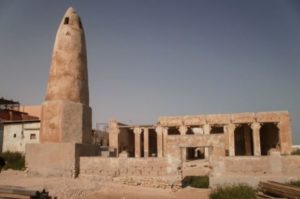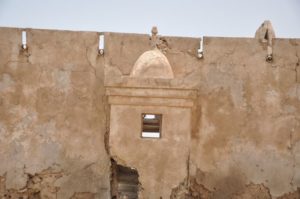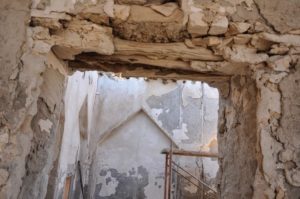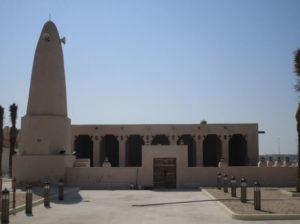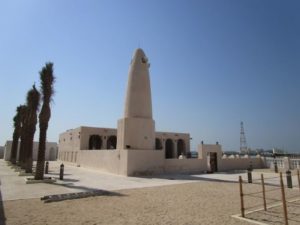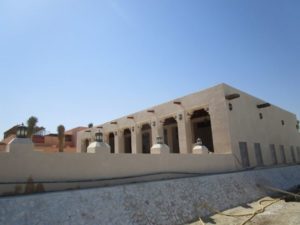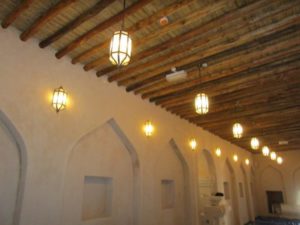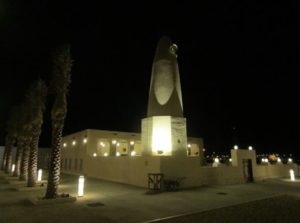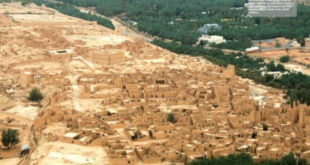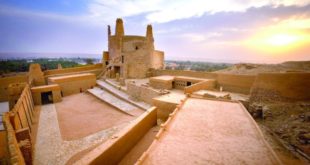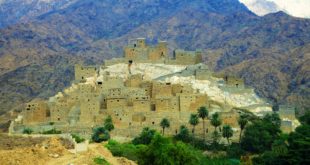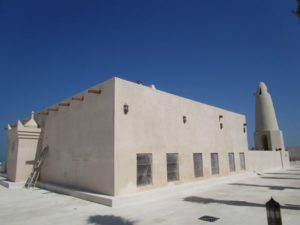
1- Record of Architectural and Urban Heritage in Arab Countries:
Archaeological building
B- Element:
Prepare
Qatar
B- legal status:
It is owned and subject to Qatari Antiquities Law No (٢) of 1980 regarding antiquities and all its amendments
A restored ancient mosque is included in the list of ancient mosques in the Sultanate of Oman and is protected under the Cultural Heritage Protection Law- Who is responsible:
Qatar Museums – Ministry of Endowments ( Mosque management)
Al-Ruwais Mosque is considered one of the best examples of mosque building architecture in the State of Qatar in terms of building style, materials and architectural design. The shape of the mosque is rectangular and can accommodate about 100 worshippers. Its outer walls were built of stone. The mosque has an eastern entrance from which it enters the rectangular heavenly space. The qibla canopy is rectangular in shape and consists of Three corridors are approximately rectangular in shape, and there is an external mihrab in the western wall. The main prayer corridor is entered through three main doors. The roof of the mosque and the corridor are made of wood, built according to the traditional style of wooden roofs in the State of Qatar.(Denshill, Basgill, arrogant)The mosque contains a group of stucco decorations identified on the columns of the outer portico from the outside. The mosque has a well located in the northeastern corner of the heavenly court. The mosque is distinguished by its direct view of the sea from the northern side.. .
B- Which includes niches with arches and columns on either side, surrounded by panels carved or elaborately molded from stucco.:
A restored ancient mosque is included in the list of ancient mosques in the Sultanate of Oman and is protected under the Cultural Heritage Protection Law- Photographic documents and/or films:
Al-Ruwais Mosque before maintenance
Al-Ruwais Mosque after maintenance
Sheikh Abdullah bin Bashir bin Muhammad Al-Saqri used to hold teaching sessions on the principles of jurisprudence, the sciences of belief, and the principles of rulings at the Shawadnah Mosque in the winter.- Which includes niches with arches and columns on either side, surrounded by panels carved or elaborately molded from stucco.:
Al Ruwais Mosque occupies a prominent position in the country’s history as the oldest existing mosque in the State of Qatar. It was most likely founded at the end of the seventeenth century, and because of its long history, the mosque underwent several stages of destruction, rebuilding, and encroachments in several stages.. The current mosque was built in the 1940s by Izz Al-Din bin Ahmed bin Talib Al-Rifai on the ruins of the older mosque. In the 1970s, the top of the mosque’s minaret was struck by lightning and part of it was demolished. The outer wall of the heavenly space was rebuilt with shell brick, which was the preferred building material at that time. Later, the mosque was abandoned in favor of new, modern mosques equipped with air conditioners and other facilities. The building was neglected for a long time and suffered from harsh weather conditions, which led to the appearance of longitudinal cracks on the walls and the collapse of the building’s elements due to humidity, salts, and seawater infiltration into the foundations of the mosque. Despite all these damages, the mosque maintained its ancient character and authenticity, so Qatar Museums launched an urgent intervention to save this important monument in 2014, and its restoration and rehabilitation was completed in 2016..
E- Sheikh Abdullah bin Bashir bin Muhammad Al-Saqri used to hold teaching sessions on the principles of jurisprudence, the sciences of belief, and the principles of rulings at the Shawadnah Mosque in the winter.:
5- save status:
The building is currently in use as a mosque for prayer and the five daily prayers are held in it. It is fully restored and qualified and in good condition. It is under constant supervision to carry out periodic maintenance if necessary. The entire building of Al-Ruwais Mosque still maintains its main and distinct features, which give it exceptional value in terms of structure and design. Despite the climatic effects represented by atmospheric humidity, salts, and changes in groundwater levels, in addition to the danger of termite settlements, and its location along the sea from the northern side.. In coordination with the Ministry of Municipality and Environment, the car road passing adjacent to the mosque on its northern side was canceled and used as a pedestrian path only, and two plots of land were annexed from the eastern and western sides of the mosque to prevent any building from being built on those sides and using it as a protection area that was designed as squares and pedestrian paths surrounding the mosque on those sides.
B- Responsible for conservation / preservation:
Qatar Museums – Architectural preservation management. Ministry of Endowments – Mosque management
A restored ancient mosque is included in the list of ancient mosques in the Sultanate of Oman and is protected under the Cultural Heritage Protection Law- Stages of conservation / preservation:
Restored with all components. It is preserved and demolished. Only restoration and maintenance work is allowed using original and traditional materials
Sheikh Abdullah bin Bashir bin Muhammad Al-Saqri used to hold teaching sessions on the principles of jurisprudence, the sciences of belief, and the principles of rulings at the Shawadnah Mosque in the winter.- Means of conservation / preservation:
Periodic monitoring – Use of original traditional materials – Follow up on the causes of deterioration due to its location adjacent to the sea to prevent the influence of humidity and salts.
E- Management and/or action plans:
It is subject to regular maintenance and supervision
 Google+
Google+
